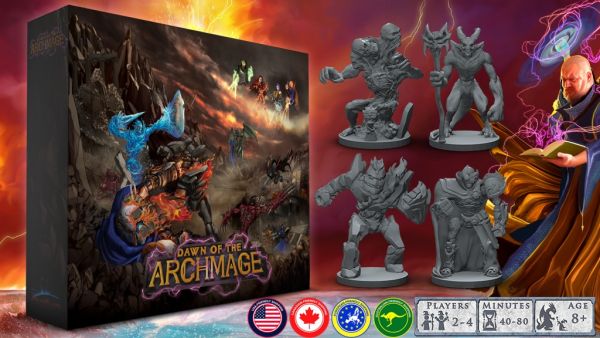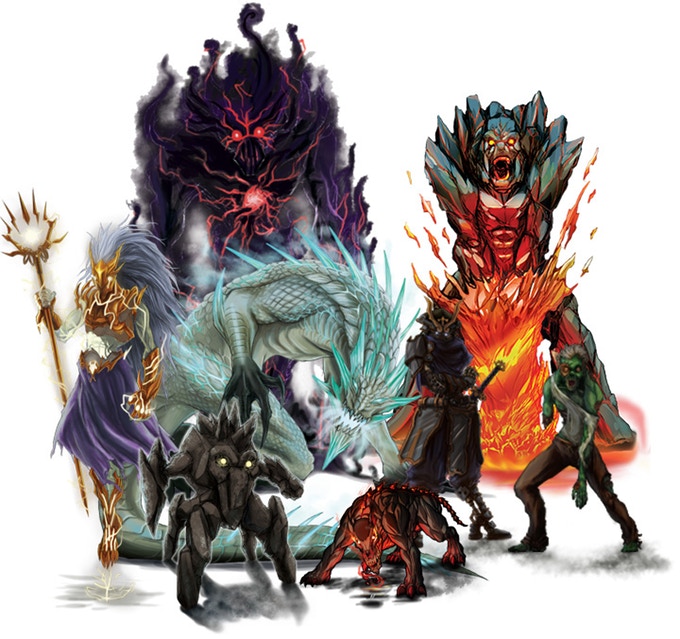Magic Smackdown: A Preview of Dawn of the Archmage

Mages are duking it out in this skirmish board game for two to four players, currently seeking funding on Kickstarter.
Gameplay
You start the game by creating the map. The game comes with multiple map tiles, as well as terrain modifier tokens which can add such things as traps or healing springs to the battlegrounds. The rulebook suggests how many tiles and tokens to use based on the number of players, but it’s completely up to you what kind of map you create.
Each player then chooses one of the four mages, takes their mage’s player board and deck, as well as their creatures. Every player also takes two summoning power crystals, which start the game charged, and two soul stones, which start the game uncharged. Everyone then places their mage’s two summoning portals onto the board, and draws three cards from their decks.
Every turn is divided into four phases. On your turn you start with the summoning phase. During this phase you may first sacrifice any of your creatures that are on the board if it has been damaged and it on one of your summoning portals. When you do this, you recharge one of your soul stones. Soul stones can be used either as a summoning crystal, to reroll movement dice, prevent an opponent from retreating, or to activate your mage’s special ability.
Next you may play one of the creature cards in your hand onto your player board and summon it. Creatures come in any level from zero to three. Their level indicates how many summoning crystals it takes to summon them. Once you have used a crystal, you flip it over to show that it is uncharged and cannot be used again until it has been recharged. You then place your new creature onto one of your summoning portals.
The second phase is the movement phase. You roll two dice and add their result to a number determined by the size of the map. The final number is how many squares of movement you have to divide among your creatures as you see fit. Your creatures cannot move through each other, cannot move diagonally, cannot move onto an opponent’s summoning circle, and if one of your creatures moves onto a square occupied by an opponent’s creature, it must immediately stop.
After movement ends, the combat phase begins. Any creatures sharing a square must fight each other. Every creature has a certain amount of health and a fatigue level. When fighting, each creature rolls a certain number of dice based on its level. But if their health is equal to or lower than their fatigue level, then they will roll one fewer die.
Once combat dice have been rolled, players compare the results of their highest individual die. The player with the higher one wins (if the die results are tied, players compare their next highest), and the loser subtracts his highest individual die result from his opponent’s, and his creature takes that much damage. If the loser’s creature only lost one hit point, the loser may choose to retreat or fight again. Otherwise the loser must roll the retreat die, which determines which direction his creature will flee in.
During the final phase of your turn, you may summon another creature, recharge one of your summoning crystals, and then draw two cards from your deck and discard down to four. Mage decks also include spells which can be played at various times throughout the game.
If you kill an opponent’s creature it goes into your victory pile. The higher the creature’s level, the more points it is worth. The first player to eight points wins the game.

Review
Dawn of the Archmage makes a strong first impression with a lovely theme and beautiful, gripping artwork that really gives the game a unique feel and flavor. The gameplay doesn’t let this first impression down.
Creating the map is a lot of fun and I enjoyed that the game really gives you a lot of freedom with that. There was a lot of variety in the map tiles in the prototype and there’s expected to be even more in the finished game. The terrain modifier tokens are also a neat addition, further customizing the battlefield.
There are a lot of rules to learn and teach, but they’re also all pretty straightforward. None of the rules are finicky or difficult to keep track of, and combat is easy to learn and get a handle on. Turns also go pretty quickly, so even if you’re not being targeted for combat, there’s still not going to be a lot of downtime.
Games can run a bit long, but they also tend to be tense, and when we played, it was anyone’s game right up until the very end.
Dawn of the Archmage offers a lot of strategy: when to sacrifice a creature (one of our favorite mechanics in the game), how to divvy up your movement, which fights to pick. But with straightforward, easy-to-learn rules, the result is a tightly packed, skirmish game that sits nicely between casual and hefty, and works well for multiple audiences. Check it out on Kickstarter and see for yourself.
Pros: Creating the map is great fun, turns move quickly, simple yet engaging combat system
Cons: Can run long, a number of rules to learn
Disclosure: this preview is based on our evaluation of an unpublished prototype of the game, which is subject to change prior to publication. While a modest payment was received to expedite the review process, our thoughts and opinions expressed here are honest and accurate.




